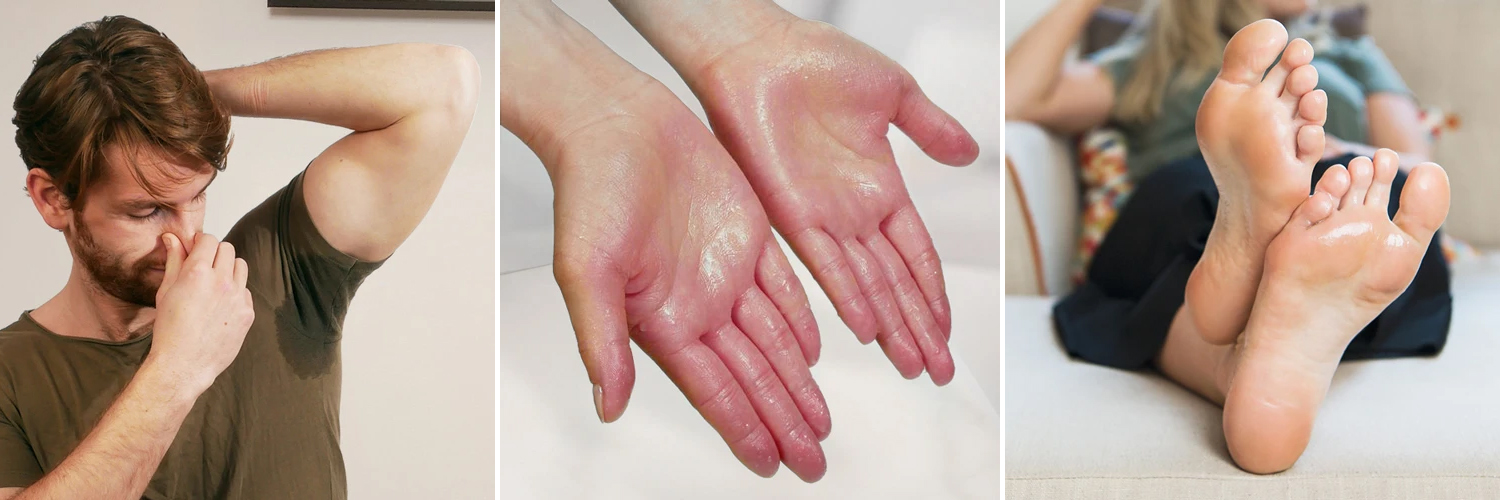Best Dermatology Approaches for Sweaty Hands Treatment: Tips and Techniques
Wiki Article
Unveiling the Complexities of Excessive Sweating: A Comprehensive Overview to Diagnosis and Management
Too much sweating, clinically known as hyperhidrosis, is a problem that influences a substantial number of individuals and can have a profound effect on their top quality of life. While sweating is an all-natural bodily function, its overactivity in hyperhidrosis presents a special collection of difficulties that commonly go beyond simple discomfort.
Recognizing Hyperhidrosis Causes
Hyperhidrosis creates can be credited to different elements such as genetics, hormone discrepancies, and specific clinical problems. Genetics play a considerable duty in key focal hyperhidrosis, where people inherit the problem from their relative. This kind of hyperhidrosis often manifests in particular locations like the hands, soles of the feet, underarms, and face. Hormonal imbalances, specifically an over active thyroid gland or menopausal adjustments, can also trigger too much sweating. Furthermore, certain medical conditions such as diabetes mellitus, heart problem, and infections can result in second generalized hyperhidrosis. These underlying health concerns can interrupt the body's natural air conditioning system, triggering the gland to end up being over active. Comprehending the origin of hyperhidrosis is crucial in detecting and efficiently handling this condition. By recognizing the certain elements adding to too much sweating, healthcare providers can tailor therapy plans to attend to the underlying cause, providing alleviation and enhancing the lifestyle for people influenced by hyperhidrosis.Recognizing Hyperhidrosis Manifestations

Moreover, hyperhidrosis signs and symptoms may manifest in psychological and social distress, as individuals might really feel self-conscious or anxious about their sweating, bring about avoidance of social circumstances (Treatment for hyperhydrosis of hands and feet). Furthermore, repeated episodes of too much sweating can lead to skin maceration, fungal infections, and an overall decrease in self-worth
Diagnostic Process for Hyperhidrosis
Initiating the analysis process for too much sweating involves thorough evaluation of the person's medical background and health examination. Asking concerning the beginning, period, and activates of sweating episodes is important to differentiate in between main focal hyperhidrosis and second generalized hyperhidrosis. Clinical background needs to additionally include inquiries regarding medications, medical problems, and household background of hyperhidrosis.Throughout the physical exam, certain attention is paid to the locations influenced by sweating. The medical care provider might analyze the level of sweating, look for indications of underlying problems, and assess the influence of sweating on the individual's quality of life. In addition, certain examinations like the gravimetric examination, starch-iodine examination, or skin conductance dimensions may be carried out to evaluate the quantity of sweat produced.
Furthermore, in cases where secondary hyperhidrosis is thought, extra examinations such as get redirected here blood examinations, pee examinations, and imaging researches might be advised to recognize the underlying cause of too much sweating. The analysis procedure intends to precisely identify the type and source of hyperhidrosis to direct proper administration methods.
Therapy Alternatives for Hyperhidrosis
When resolving too much sweating, different treatment options are available to minimize symptoms and improve the person's top quality of life. The therapy strategy for hyperhidrosis depends upon the seriousness of symptoms and the patient's feedback to first therapies.Topical therapies, such as aluminum-based antiperspirants, are usually advised as the very first line of defense for taking care of light situations of hyperhidrosis. These products function by plugging the sweat ducts, therefore lowering the quantity of sweat that reaches the skin's surface area. For individuals with more extreme signs, oral drugs like anticholinergics might be prescribed to aid reduce sweating. However, these drugs can have negative effects and are not suitable for every person.

Effective Administration Techniques
To successfully manage hyperhidrosis, a individualized and extensive treatment strategy tailored to the patient's specific requirements and feedback to previous treatments is necessary. This strategy might integrate a combination of restorative strategies, consisting of lifestyle modifications, topical therapies, dental drugs, botulinum contaminant injections, iontophoresis, and in serious situations, medical interventions like sweat gland removal or sympathectomy. Way of living alterations such as using moisture-wicking clothes, using antiperspirants, and exercising stress-reducing strategies can match medical interventions. Topical antiperspirants having aluminum chloride are typically the first-line treatment, with more powerful formulas available for immune situations. Dental medications like anticholinergics might be recommended for generalized hyperhidrosis. Botulinum contaminant injections are effective for focal hyperhidrosis, providing momentary alleviation by blocking the launch of acetylcholine. Iontophoresis, including making use of a reduced electrical existing to minimize sweat gland task, can be helpful for both palmoplantar and axillary hyperhidrosis. Surgical choices are generally booked for serious, refractory instances and need mindful consideration of benefits and dangers. A multidisciplinary approach including skin doctors, key care medical professionals, and, if required, doctors, can enhance the monitoring of hyperhidrosis.
Final Thought
In verdict, hyperhidrosis is a problem characterized by too much sweating, which can substantially influence a person's high quality of life. With appropriate diagnosis and management strategies, people enduring from hyperhidrosis can discover relief and improve their overall health.Too much sweating, medically known as hyperhidrosis, is a problem that influences look at here a considerable number of individuals and can have a profound influence on their high quality of life. By determining the specific variables adding to too much sweating, medical care suppliers can customize therapy strategies to Related Site attend to the underlying reason, offering relief and improving the top quality of life for individuals affected by hyperhidrosis.
Hyperhidrosis, characterized by extreme sweating beyond what is essential for controling body temperature level, can substantially influence a person's high quality of life. Making inquiries regarding the start, period, and triggers of sweating episodes is vital to separate between main focal hyperhidrosis and secondary generalized hyperhidrosis. Exessive Sweating.In conclusion, hyperhidrosis is a problem defined by too much sweating, which can considerably influence an individual's high quality of life
Report this wiki page